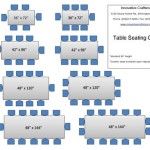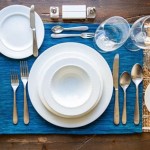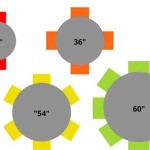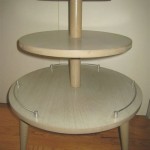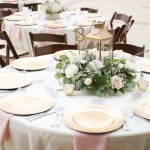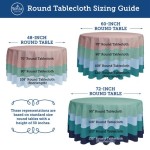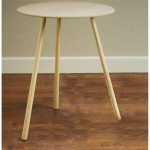How to Make a Too-Large Tablecloth Fit a Smaller Table Size for a Wedding
Securing the perfect tablecloth for a wedding reception can be a challenging task. Often, availability or cost considerations may lead to purchasing or acquiring tablecloths that are larger than the tables they are intended to cover. While a perfectly sized tablecloth presents an elegant appearance, an oversized tablecloth can be adapted to fit a smaller table without compromising the overall aesthetic. This article outlines several methods for effectively managing an oversized tablecloth to ensure a polished and sophisticated look for a wedding reception.
The primary concern when fitting a larger tablecloth onto a smaller table is preventing excessive fabric from pooling on the floor or creating an uneven, cluttered appearance. The chosen method will depend on factors such as the fabric type, the desired level of formality, and the availability of tools and resources. Each technique aims to distribute the excess fabric gracefully, creating the illusion of a custom-fitted tablecloth.
Employing Tablecloth Clips or Weights
One of the simplest and most accessible methods for managing an oversized tablecloth involves the use of tablecloth clips or weights. These accessories work by securing the excess fabric at strategic points around the table's perimeter, preventing it from draping excessively or becoming a tripping hazard. This approach is particularly suitable for informal weddings or outdoor receptions where wind might be a factor.
Tablecloth clips are typically metal or plastic devices that clamp onto the edge of the table, effectively shortening the hemline of the tablecloth. They come in various styles, ranging from utilitarian options to decorative designs that can complement the wedding's theme. The number of clips needed will depend on the size of the tablecloth and the extent of the overhang. As a general guideline, placing clips every 12-18 inches should provide sufficient security and a visually balanced appearance. Before the clips are used, ensure the tablecloth is smoothly draped over the table, with the excess fabric evenly distributed along all sides. Clips should be attached discreetly, preferably on the underside of the tablecloth, to minimize their visibility.
Tablecloth weights offer a similar function but rely on gravity to hold the fabric in place. These weights are attached to the corners or along the edges of the tablecloth, preventing it from billowing or dragging on the floor. Weights are available in a wide range of materials, including metal, glass, and ceramic, and can be chosen to match the wedding's aesthetic. Some weights are designed to clip onto the fabric, while others hang freely. When using weights, it's crucial to distribute them evenly to maintain a balanced appearance. Heavier weights are preferable for outdoor events or situations where the tablecloth is likely to be exposed to wind. However, care should be taken to avoid using weights that are too heavy, as they could potentially damage delicate fabrics.
While tablecloth clips and weights offer a quick and easy solution, they may not be ideal for formal weddings where a more refined appearance is desired. These accessories can sometimes detract from the overall elegance of the table setting. In such cases, alternative methods should be considered.
Creating Pleats or Folds
For a more tailored and sophisticated look, the excess fabric can be skillfully folded or pleated to create a more fitted appearance. This technique requires more time and effort but results in a cleaner and more polished presentation. The key to success lies in creating even and symmetrical folds that distribute the excess fabric uniformly around the table.
One common method involves creating inverted box pleats along the edges of the tablecloth. To accomplish this, begin by draping the tablecloth over the table and determining the amount of excess fabric. Then, create a series of inverted box pleats by folding the fabric inwards towards the table, creating a series of vertical folds. Secure each pleat with pins or temporary basting stitches to hold it in place. The number and size of the pleats will depend on the amount of excess fabric. Ensure that the pleats are evenly spaced and symmetrical, both in the front and back and on either side.
Another option is to create simple folds along the edges of the tablecloth. This technique is particularly suitable for rectangular tables. The excess fabric is folded inwards, creating a clean, straight edge. The folds can be secured with pins or fabric glue to prevent them from unraveling. For a more decorative effect, the folded edge can be embellished with ribbon or trim. In some cases, depending on the nature of the fabric and the desired aesthetic, the folds are maintained in place using a steam iron. Applying steam to the fabric, in conjunction with tension and proper folding, can create a crisp and permanent look.
When creating pleats or folds, it's essential to work on a flat, clean surface to ensure accurate and consistent results. Using a measuring tape can help to create uniform pleats or folds. Also, it's advisable to practice on a small section of the tablecloth before committing to the entire project. Careful attention to detail will ensure a professional and elegant finish.
The advantage of pleated or folded tablecloths is that the modifications create a refined, professional appearance. The lack of external fasteners or weights give it a clean, sharp look. One disadvantage is that the task is very labor and time-intensive, especially if a large number of tables need to be prepared with oversized cloths. However, for a formal and sophisticated presentation, this method can be very effective.
Utilizing Elastic Bands or Drawstrings
A less common but potentially effective method involves using elastic bands or drawstrings to gather the excess fabric underneath the table. This technique is particularly suitable for round or oval tables where creating pleats or folds may be more challenging. The goal is to create a gathered effect that pulls the excess fabric inwards, creating a more fitted appearance.
To use elastic bands, begin by draping the tablecloth over the table and determining the amount of excess fabric. Then, measure the circumference of the table and cut a length of elastic band that is slightly shorter than the circumference. Attach the elastic band to the underside of the tablecloth, along the edge, using pins or stitches. As the elastic band is stretched and attached, it will gather the excess fabric, creating a ruched effect. Ensure that the elastic band is evenly distributed around the table to maintain a balanced appearance. Use a strong needle and heavy-duty thread when stitching the elastic to the cloth.
Alternatively, a drawstring can be used to achieve a similar effect. In this case, a casing is created along the edge of the tablecloth, and a drawstring is threaded through the casing. The drawstring is then pulled tight, gathering the excess fabric. The drawstring can be secured with a knot or a drawstring stopper. This method allows for greater adjustability, as the drawstring can be tightened or loosened as needed.
When using elastic bands or drawstrings, it's important to choose materials that are strong and durable. The elastic band or drawstring should be able to withstand the tension of the gathered fabric without breaking or stretching out. Also, the attachments should be secure to prevent the fabric from unraveling. The use of a reinforcement stitch can strengthen the attachment points between the elastic band, the drawstring, and the tablecloth.
The elastic or drawstring method offers a discreet way to manage excess fabric, as the gathering is concealed underneath the table. This technique is particularly useful for tablecloths made from lightweight fabrics that are prone to billowing. However, it may not be suitable for formal events where a perfectly smooth and tailored appearance is desired. The gathered effect can sometimes look slightly less polished than pleats or folds.
Considering Temporary Hemming with Fabric Tape
For a relatively quick and visually clean solution without the commitment of permanent alterations, consider hemming the tablecloth temporarily using fabric tape. This method is suitable for tablecloths that have a significant excess length and offers a more refined appearance than clips or weights while being less time-consuming than pleating.
Fabric tape, also known as hemming tape or fusible webbing, is a double-sided adhesive that bonds fabric together when heated with an iron. To use this method, start by measuring the desired hem length around the table. Fold the excess fabric inwards along this line, creating a clean, even hem. The fold should be pressed with an iron to create a crisp crease.
Next, insert a strip of fabric tape between the folded fabric and the main body of the tablecloth, ensuring it's positioned close to the folded edge. Follow the manufacturer's instructions to activate the adhesive, typically by applying heat with an iron. Press the iron firmly over the folded area for the recommended time, ensuring even heat distribution. The heat will melt the adhesive, bonding the folded fabric together and creating a temporary hem.
It is crucial to test the fabric tape on a small, inconspicuous area of the tablecloth first to ensure it doesn't damage or discolor the fabric. Different fabrics react differently to heat and adhesives, and some may not be suitable for this method. Furthermore, be aware that this hem is temporary. The adhesive may lose its strength over time or after washing, requiring the hem to be reapplied. This method is best suited for single-use events like weddings.
The fabric tape method offers a clean, professional look without requiring sewing skills. The hem is hidden underneath the tablecloth, creating a smooth and even drape. However, it's important to choose a high-quality fabric tape that provides a strong bond and is compatible with the tablecloth fabric. Rushing the ironing process or using an unsuitable tape can result in a poorly adhered hem that easily comes undone.
Ultimately, selecting the optimal method for adapting an oversized tablecloth to a smaller table involves weighing the desired aesthetic, the available resources, and the time constraints. The options outlined above offer a spectrum of solutions, ranging from simple and practical to more elaborate and refined, suitable for various wedding styles and levels of formality. Careful planning and execution will ensure that the tablecloth enhances rather than detracts from the overall ambiance of the wedding reception.

How To Make A Tablecloth Fit Any Table Shape Or Size O Sewing

Let S Talk Linens The Ultimate Guide To Table Linen Sizes Party Al Ltd Pink Hippo Blog

Tablecloth Size Guide Table Linen Hire Tips Plato Catering

Rectangle Tablecloth On Round Table Choosing The Size Materials Tablecoversnow Com

Tablecloth Size Chart

How To Make A Tablecloth Fit Any Table Shape Or Size O Sewing

Wedding Planning Tables Cosmoering Com

Tablecloth Size Guide Table Linen Hire Tips Plato Catering

Guide To Wedding Reception Tables Chair Decor

Bend Table Linen Als Your Ultimate Guide To Choosing Sizes For Events
Related Posts

